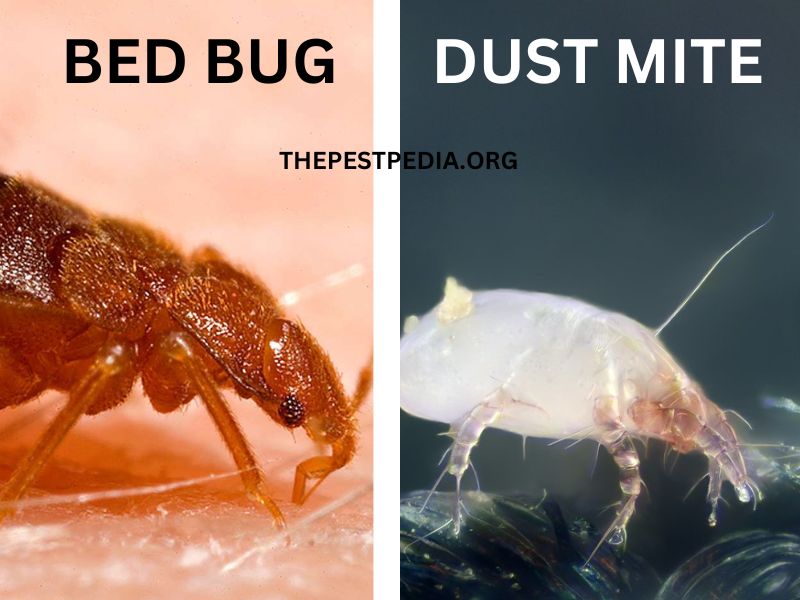If you want to know the comparison between bed bugs and dust mites then here is some Bed Bugs vs Dust Mites: A Comprehensive Comparison
This is the comparison table for bed bugs and dust mites.
| Bed Bugs | Dust Mites | |
| Overview | Bed bugs are small red insects most suck blood from the host (Humans & Animals) | Dust Mites are micro insects that feed on dead skin. |
| Size | The size of bed bug is almost a size of an apple seed. A nymph size is 1.5 mm | A dust mite measures only about one-quarter to one-third of a millimeter. They are too small to see with your eyes alone. |
| Color | Bed bugs are red their nymphs are white. | The color of dust mites is creamy white |
| Disease | No Disease | They can spread dust mite allergy |
| Symptoms | Bed bugs’ eggs, fences, shells, and bites at the night. | Sneezing, Runny noseItchy, red, or watery eyes, Nasal congestionItchy nose, the roof of the mouth, or throat. |
- Quick Overview
- Bed Bugs vs Dust Mites: Physical Characteristics and Identification
- Bed Bugs vs Dust Mites: Habitat and Behavior
- Bed Bugs vs Dust Mites: Health Impacts and Symptoms
- Bed Bugs vs Dust Mites: Detection and Monitoring
- Bed Bugs vs Dust Mites: Control and Prevention
- Bed Bugs vs Dust Mites: Long-term Prevention
- When to Seek Professional Help
- Additional Resources
Quick Overview
Bed bugs are blood-feeding ectoparasites that exclusively target humans and other warm-blooded animals. While they don’t transmit diseases, their bites can cause significant psychological distress and allergic reactions. Dust mites (Dermatophagoides species) are microscopic arachnids that feed on dead skin cells and can trigger various respiratory allergies and asthma symptoms.

Bed Bugs vs Dust Mites: Physical Characteristics and Identification
Bed Bugs
- Size: Adults measure 4-5mm in length (approximately apple seed size)
- Morphology: Oval-shaped, flat bodies that become engorged and reddish after feeding
- Life Stages:
- Eggs (1mm, pearly white)
- Five nymphal stages (1.5-4mm)
- Adults (4-5mm)
- Color Variation: Unfed adults are mahogany brown, fed adults are reddish-brown, nymphs are translucent to light brown
Dust Mites
- Size: 0.2-0.3mm in length (invisible to naked eye)
- Morphology: Eight-legged arachnids with translucent bodies
- Life Stages:
- Eggs (0.1mm)
- Larval stage (six-legged)
- Two nymphal stages
- Adults
- Specific Species: Main household species include:
- Dermatophagoides pteronyssinus (European house dust mite)
- Dermatophagoides farinae (American house dust mite)
Bed Bugs vs Dust Mites: Habitat and Behavior
Bed Bugs
- Preferred Locations:
- Mattress seams and tufts
- Bed frames and headboards
- Baseboards and wall-floor junctions
- Electrical outlets and switch plates
- Activity Pattern: Nocturnal, most active between 2:00-5:00 AM
- Dispersal: Actively crawl and spread through human movement
- Environmental Requirements:
- Temperature: 20-28°C (68-82°F)
- Relative Humidity: Can survive in varied conditions
- CO₂ sensitive for host detection
Dust Mites
- Preferred Locations:
- Bedding materials (mattresses, pillows)
- Carpeting and upholstered furniture
- Areas with high human dander accumulation
- Environmental Requirements:
- Temperature: 20-25°C (68-77°F)
- Relative Humidity: 65-80% (critical for survival)
- Die when humidity drops below 50%
Bed Bugs vs Dust Mites: Health Impacts and Symptoms
Bed Bug Effects
- Physical Reactions:
- Linear bite patterns (“breakfast, lunch, dinner” pattern)
- Wheals and papules
- Potential severe allergic reactions
- Psychological Impact:
- Insomnia
- Anxiety
- Post-traumatic stress symptoms
Dust Mite Allergies
- Respiratory Symptoms:
- Persistent sneezing
- Rhinitis
- Nasal congestion
- Other Reactions:
- Atopic dermatitis
- Asthma exacerbation
- Conjunctivitis
Bed Bugs vs Dust Mites: Detection and Monitoring
Bed Bug Detection
- Visual inspection using flashlight
- Monitoring devices:
- Interceptor traps
- Glue boards
- CO₂ monitors
- Signs of infestation:
- Fresh fecal matter (black spots)
- Cast skins
- Egg cases
- Sweet, musty odor in heavy infestations
Dust Mite Detection
- Professional sampling methods:
- Vacuum sampling
- Tape lifting
- ELISA testing for allergen levels
- Environmental monitoring:
- Humidity meters
- Temperature tracking
Bed Bugs vs Dust Mites: Control and Prevention
Bed Bug Management
- Non-Chemical Control:
- Heat treatment (sustained 120°F/49°C)
- Cold treatment (-0°F/-18°C for 4 days)
- Steam cleaning
- Mattress encasements
- Chemical Control:
- Pyrethroids
- Desiccants
- Growth regulators
- Professional-grade residual sprays
Dust Mite Management
- Environmental Control:
- Maintain humidity below 50%
- Regular HEPA vacuuming
- Hot water washing (130°F/54°C)
- Allergen-proof encasements
- Prevention Strategies:
- Regular cleaning schedule
- Dehumidification
- Removal of carpet in sensitive areas
- Air purification systems
Bed Bugs vs Dust Mites: Long-term Prevention
Bed Bug Prevention
- Regular inspection protocols
- Travel precautions
- Professional monitoring services
- Staff training (for commercial properties)
Dust Mite Prevention
- Climate control systems
- Regular replacement of bedding
- Proper ventilation
- Allergen reduction plans
When to Seek Professional Help
- Large-scale infestations
- Failed DIY treatments
- Health concerns
- Property management requirements
Additional Resources
Allergy specialist referrals
Local health department guidelines
EPA-registered product lists
Pest management associations
Read More:-
- Can bed bugs live in plastic mattresses?
- Can you use cockroach spray on bed bugs?
- Bed bugs vs bat Bugs
Hey, I am Chetan Kumar and I have a deep knowledge of bed bugs, flies, rats, roaches, and other notorious pests. So I thought let me help all of you so I created this amazing website called pestpedia.org. If you like this website, let me know with your comments. Till then enjoy…
